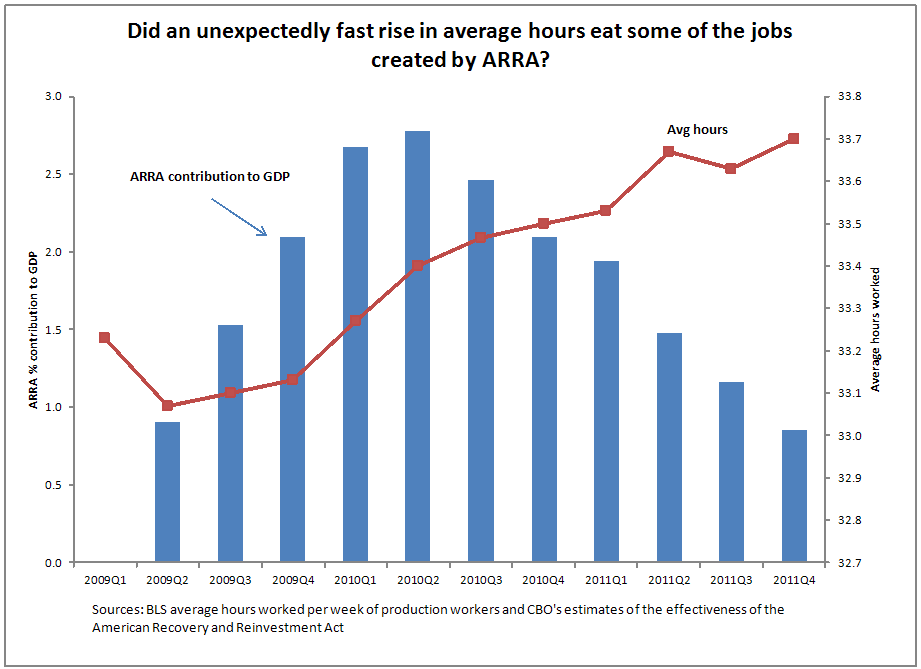Were some of ARRA’s jobs eaten by rising hours?
Speaking of rising hours, it’s also interesting to note that the atypically large rise in average hours since the recession’s trough happened to coincide with the period during which the American Recovery and Reinvestment Act (ARRA) was providing its peak boost to economic activity (see the figure below).
Between the first half of 2009 and first half of 2011, ARRA boosted GDP by roughly 1.3 percent. All else equal, this should have been associated with employment in the first quarter of 2011 that was roughly 1.5 million higher and unemployment that was a full percentage point lower by the first quarter of 2011 than would’ve happened without ARRA.*
But, over this same period, average hours worked rose by 1.4 percent. All else equal this implies that about 1.5 million new workers were not needed to absorb rising demand for labor.
To be clear, everybody who tries to translate additional economic activity spurred by ARRA (or anything else) into an increase in employment makes an adjustment for average hours increasing as the economy exits a recession and begins growing again – it’s a pretty typical pattern. But, as pointed out before, the rise in hours in the recovery following the Great Recession was atypically large and the GDP-to-employment translations may have been off because of it.

Of course, the most common criticism levied against ARRA by its critics was some version of the argument that “you guys saying it’s boosting the economy, but job-growth is really slow and unemployment is rising.”
So does the fact that rising hours may have crowded out potential new hires while ARRA was creating new demand then mean that the critics are right about the Recovery Act’s ineffectiveness?
Nope. ARRA created new demand for labor by boosting economic activity. Period. American workers as a group worked more and earned more money because of ARRA.
But it does tell us that we might not be so sure about how this new labor demand was allocated – and in fact it seems like more of it went to increasing the hours of incumbent workers and less went to increasing new hires than we may have thought.
One metric does not change, however: the estimate of full-time equivalent jobs created by ARRA. This measure holds hours constant by design. In short, this seems like the safest bet for having a solid assessment of what ARRA did. And for the record, at its peak during the last half of 2010, full-time employment was between 1 to 6 million higher because of ARRA, regardless of what was happening to hours.
The possibility that lots of the new employment opportunities created by ARRA were filled by increasing hours of incumbent workers rather than new hires may, of course, have meant that that ARRA was less effective from a political perspective. Had more of its boost to economic activity shown up in top-line labor market indicators like new hires and lower unemployment, its proponents (like me) might have had an easier job demonstrating just how important it was.
*All numbers on ARRA’s effectiveness in this post come from the CBO
Enjoyed this post?
Sign up for EPI's newsletter so you never miss our research and insights on ways to make the economy work better for everyone.